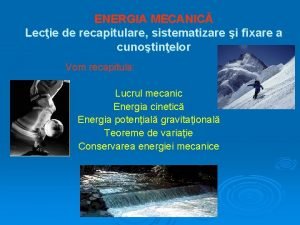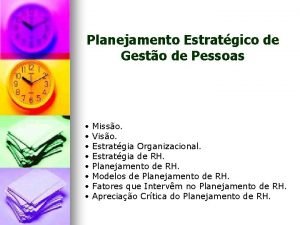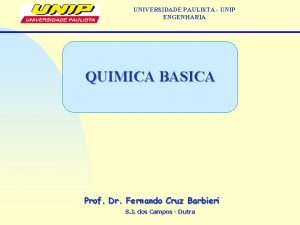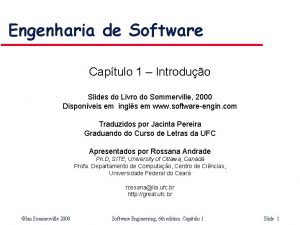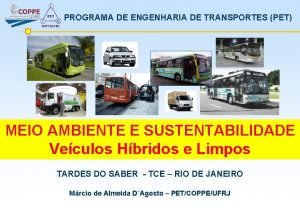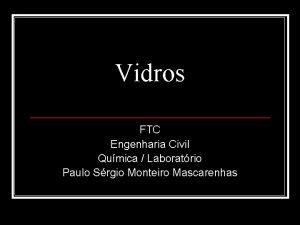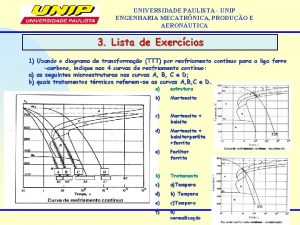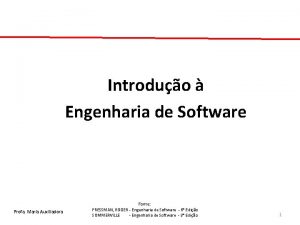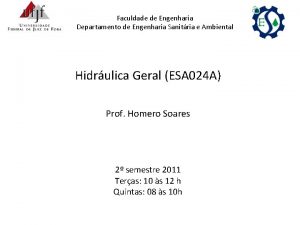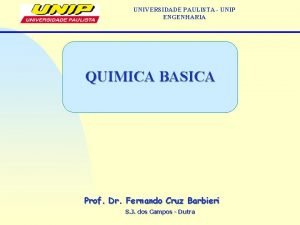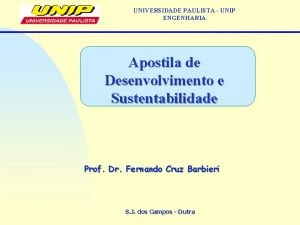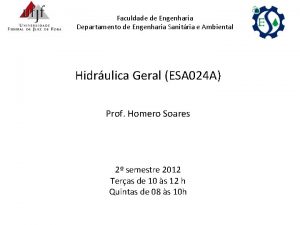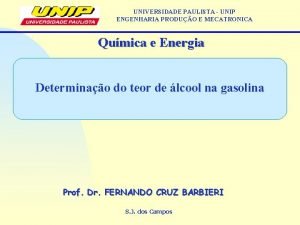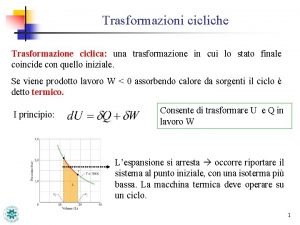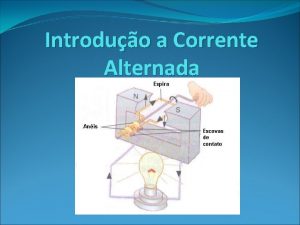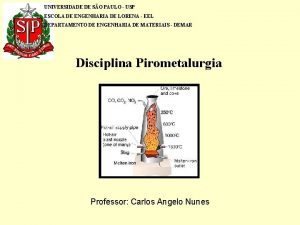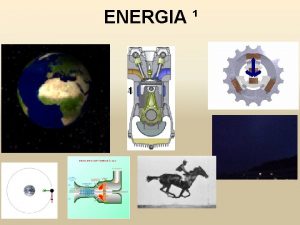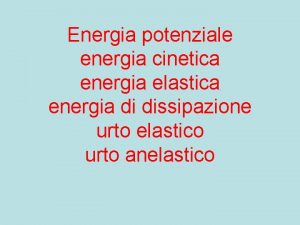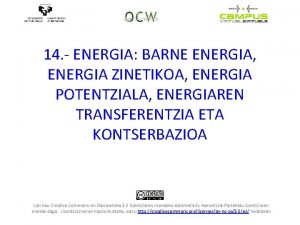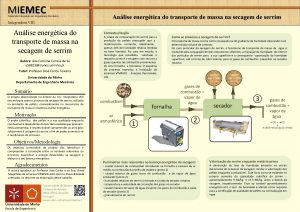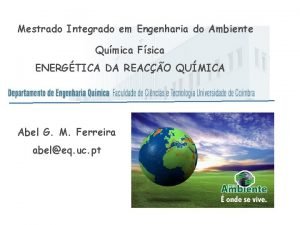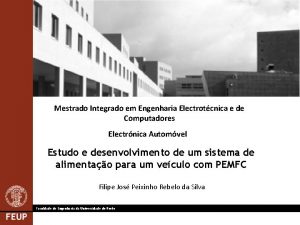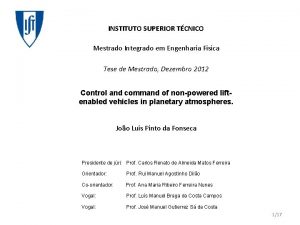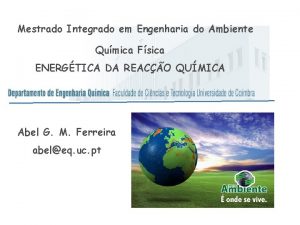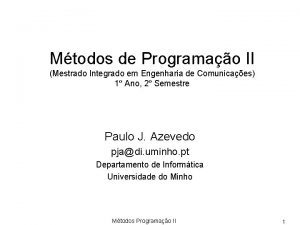MESTRADO INTEGRADO EM ENGENHARIA DA ENERGIA E DO
















![Energy potential of agricultural waste in EU-27 Total resíduos Biogas Metano [106 tons] [106 Energy potential of agricultural waste in EU-27 Total resíduos Biogas Metano [106 tons] [106](https://slidetodoc.com/presentation_image/422152c5c5d39e7bfd67d6cc24cb3c6b/image-17.jpg)

















































![Two-platform biorefinery concept Source: NREL 2006, Biomass Programm, DOE/US] 67 Two-platform biorefinery concept Source: NREL 2006, Biomass Programm, DOE/US] 67](https://slidetodoc.com/presentation_image/422152c5c5d39e7bfd67d6cc24cb3c6b/image-67.jpg)



- Slides: 70

MESTRADO INTEGRADO EM ENGENHARIA DA ENERGIA E DO AMBIENTE Bioenergy Aula N 4 Santino Di Berardino Santino. diberardino@lneg. pt

Energy and civilization l The availability of energy has been the key to the evolution of modern civilization. It may be the key to your survival. l On average, each human being, out of the 6 billion people in the world, consumes two tons of coal for energy production. l There is a big difference between industrialized and developing countries. One European consumes more than six tonnes of coal, which is 40 times more expensive, than the consumption of a human being in Bangladesh. l Today, 90 percent of the energy sources used are of fossil origin and their use is associated with dioxide emissions into the atmosphere. Thus, annually, the terrestrial atmosphere receives more than 15 billion tons of CO 2, which implies irreversible damages in the climate. However, meeting the energy needs of civilization need not be based on fossil energy sources. 2

Energy Consumption in the world Energia da biomassa 3

Electric anaergy consume per capita 2007 (fonte: BP 2008) 4

Why do we need bioenergy? l Energy is needed every where and makes our lives pleasant, whether in the form of heating, electricity or fuel. l Generally speaking, the higher a country’s standard of living, the more energy it consumes. l Water, wind and wood supplied the energy necessary for industrialisation to take place in the 18 th century. These renewable energy sources were quickly replaced in the 19 th century by coal, oil and gas. l Today, approximately 90 % of energy used worldwide is produced from fossil resources. This diminish coal and oil reserves and also has consequences for the climate and for the environment. l Producing energy from fossil raw materials releases large quantities of carbon dioxide (CO 2) into the atmosphere in a short time, exacerbating the greenhouse effect. l Converting wood, residues or energy crops into energy, they only produce about as much CO 2 as they had previously fixed during their growth. There is therefore a closed carbon cycle. 5

Consume of energy varies WITH Life standard l Energy consume and Life standard (PIB). 6

World energy consume by fuel 7

World energy consume by sector 8

Future of Energy supply l Meeting the energy needs of civilization need not be based on fossil energy sources. 9

Biomass for bioenergy The following materials can be used in the generation of bioenergy: • Wood and wood waste; • The organic part of municipal and industrial solid waste; • Sewage; • Manure and agro-industrial effluents; • Crop plants and plant by-products for food production. • woody biomass, directly combusted to generate heat and/or electricity. Energia da biomassa 10

Conventional and alternative energy sources l The conventional sources are: Fossil and nuclear energies. l Alternative sources are natural resourse with ciclic or etern properties, constant and not limitedutilizam recursos naturais l Eolic Energy, geothermic, solar hidraulic, wawes, tidal and biomass energy. 11

Evolution of energy sources 12

Bioenergy Potential 13

Evolução da biomassa até 2020 14

15

EU potential l 182 Mtoe can be obtained from the biomass grown on 20% of arable land in the EU-27. l This corresponds to more than 10% of primary energy demand in 2020, l Equivalent to 50 -60% of the share of renewable energy 16
![Energy potential of agricultural waste in EU27 Total resíduos Biogas Metano 106 tons 106 Energy potential of agricultural waste in EU-27 Total resíduos Biogas Metano [106 tons] [106](https://slidetodoc.com/presentation_image/422152c5c5d39e7bfd67d6cc24cb3c6b/image-17.jpg)
Energy potential of agricultural waste in EU-27 Total resíduos Biogas Metano [106 tons] [106 m 3] 1, 578 31, 568 20, 519 Potencial [PJ] [Mtoe] 827 18. 5 Heat of combustion of methane: 40. 3 MJ / m 3; 1 Mtoe = 44. 8 PJ Assumed methane content in biogas: 65% 17

Forecast of Biogas production (Mtoe): Produção actual (2008) de biogas in EU 27: 7 2012 -2015 EU Previsão 15 Potencial agropecuária 18. 5 -20 Resídusos Orgânicos e subprodutos 15 -20 Culturas e resíduos agrícolas 20 -30 Previsão total a longo prazo de Biogás 60 O Biogas pode absorver 1/3 of EU’s da procura total de ER (20%) no ano de 2020 18

Forecast energy consumption Estimated Toital Forecast energy value consume PJ/ano Source Sanders J. : Biorefinery, the Total enery need bridge between Agriculture 1 000 and Chemistry. Workshop: year of 2050 Energy crops & Bioenergy. Total energy demand 1 300 000 Shell’s World Energy Scenario year of 2050 19

Bioenergy utilization chain The figure describes the bioenergy utilisation chain from sources of biomass, to biofuel production to final use of bioenergy (CEN/TS 14588). Energia da biomassa 20

Energy from biomass It is the solar energy fixed by the photosynthetic process and accumulated in the organic molecules derived. . This energy is released in oxidation processes (reactions that degrade the biological molecules) giving as final products CO 2 and H 2 O. Mat. Org. + O 2 = CO +H 2 O Energy can be obtained by direct processes or by derived compounds (fuels) that yield their energy in the oxidation processes. 2 21

Oxidation-reduction reactions l Oxidation and reduction are complementary chemical processes, known as redox reactions involving the loss of electrons by one of the reactants (oxidation) and the corresponding gain of electrons by another reactant (reduction). l The chemical species that loses electrons is oxidized and acts as a reducing agent (donor electrons) and the chemical species that accepts electrons is reduced and acts as an oxidizing agent (electron acceptor). 22 22

Example l CO 2(g)+H 2(g)→ 2 CO(g)+H 2 O(g) The hydrogen gas is being oxidized (reductant), an overall loss of electrons for the resulting molecule. Similarly, we expect to see a gain in the overall number of electrons for the resulting molecule of the oxidant (CO 2). l 23 23

Example l REDUCTION Photosinthesis 6 CO 2+6 H 2 O→C 6 H 12 O 6 +6 O 2 The light-driven reduction of CO 2 l OXIDATION l C 6 H 12 O 6 + O 2 → 6 CO 2 + 6 H 2 O +Energy Energy-yielding oxidation of glucose reaction 24 24

Example l Some common oxidation processes are the oxidation of metals (which includes the formation of "rust" or iron oxide) and combustion. l Fluorine is the strongest oxidant. l common oxidizing agents are hydrogen peroxide (hydrogen peroxide) and the hypochlorite ions contained in the liquids. l When a car is started the oxidation or explosion of gasoline that provides energy occurs. l Biomass burning is an oxidation-reduction reaction 25 25

Oxidation in biological Processes l All living things depend on oxidation-reduction reactions to stay alive and to obtain the energy necessary for the body's metabolism. l When we breathe it is introduced into the lungs the oxygen necessary for the oxidation and energy supply to the cells l In the synthesis of energy-rich compounds, photosynthesis and cellular respiration, a complex set of reactions takes place involving the transfer of electrons between various intermediates, which alternate between an oxidized form and a reduced form. 26 26

Oxidation in biological Processes -2 l This electron transport chain ends up in oxygen (in an environment exposed to this compound), which is of great importance as the final acceptor of electrons l In the case of anaerobic microorganisms, it ends in the sulfur or other compounds that take the role of O 2, forming H 2. l In anaerobic digestion oxidation is partial the available oxidant is Hydrogen and Methane is formed. 27

Energy transfer between trophic levels It is estimated that only about 10% of available energy at a trophic level is used by the following trophic level: Energy available at each trophic level is reduced at 10 % meaning that are not possible more than 5 links in a food chain 28

Energy Flow Diagram Cada nível Trófico incorpora 10 % da energia do nível precedente 29

Tipe of biomass l Liquid l Sólid l Gas 30

Biomass for energy l Biomass is the oldest form of supplying energy to mankind. Modern sources of bioenergy, such as briquettes, pellets or wood chips, wood trunks, wood gas, biogas and vegetable oil or biodiesel, offer a high potential for the use of innovative energies. l These natural fuels can be used in stationary applications to supply heat and energy to homes, public buildings, agriculture and industry. The biodiesel, generated from harvests for energetic purposes, can be used in motors for motor vehicles, for which only minor modifications 31

Biomassa - bioenergy l The use of biomass as a renewable fuel can reduce the ecological footprint of all nations with regard to energy, l It may be the solution for minimizing climate change and other environmental problems. l The energy from biomass sources is considered to be neutral in terms of climate damage due to the greenhouse effect, because although the energy stored in the biomass emits greenhouse gases such as carbon dioxide, the amount released is the same which was consumed during the process of photosynthesis. l In contrast to the direct use of solar or wind energy, biomass as a carrier of renewable energy is available and can replace the various forms of energy (electricity, heat, and fuel) produced by fossil sources. 32

Biogas-Biofuels Definitions l Since the organic plant matter has absorbed carbon dioxide as it grows, when it is finally burnt to generate bioenergy it releases a comparable amount of carbon back into the atmosphere. l Agricultural biofuel production is in potential competition with agricultural food production. Bioenergy crop production is rapidly increasing in the EU, and in 2011 used 13% of Europe’s agricultural land. The land demand of bioenergy crops can be contentious and needs to be balanced in the context of an overall sustainable approach to land management. Energia da biomassa 33

Biogas-Biofuels Definitions l Biofuels means fuels produced directly or indirectly from biomass and bioenergy denotes energy form biofuels l Biogas, primarily methane and carbon dioxide, is produced through the bacterial decomposition of organic matter. l Biofuels are liquid fuels from a non-fossil biological origin and also represent a renewable energy resource. l Biofuels can be divided into biogasoline and biodiesel depending on the material of origin used. Energia da biomassa 34

Biomass - bioenergy l Biomass is the only renewable energy that can be converted into gaseous, liquid or solid fuels by means of known conversion technologies. It can be used in a wide range of applications in the energy sector. l At present it is possible to provide biomass energy for the full range of energy applications, from heating structures to supplying transport fuels. l The range of possible uses of biomass, the advantages of safe and harmless storage, and the possibility of integrating local fuel suppliers, namely agricultural and forestry companies, offer a wide range of sustainable applications. 35

Type and sources of Biomass uma extensa categoria de materiais: Tipo de Biomassa • Resíduos florestais, • Resíduos agrícolas lenhosos • Resíduos agrícolas herbáceos • Productos lignocelulósicos • Resíduos agro-pecuários • Lamas de ETAR • Resíduos Sólidos Urbanos • Resíduos de industrias forestais • Resíduos de industrias agrícolas • Óleos usados ORIGEM agro/florestal Resíduos Urbanos e industriais • Cultivos de cereais, milho etc. • Girasol, colza Cultivos Alimentares Culturas bioenergéticas. Cultivos energéticos 36

Bioenergy production • About 14% of the world's energy is currently derived from biomass, equivalent to 25 million barrels a day, mostly (two thirds), produced and used in the underdeveloped countries, being the largest source of primary energy. On the other hand, biomass supplies about 35% of the energy needs of developing countries. • In developed countries, the weight of biomass energy is reduced to only 3% of national energy consumption. It is necessary to deal with and work with biomass more efficiently, to plan more advantageous forms of primary production and to evolve in the area of conversion and exploitation of primary biomass in chemicals and fuels. • The reorganization of the world's territory with a view to encouraging the production of biomass enables it to combat a number of environmental degradation phenomena such as climate change, greenhouse effect, erosion, desertification, deforestation, etc. • The annual production of biomass via photosynthesis corresponds to eight times the total world energy consumption, there being a potential that can be valued and managed in a way that can support the development of humanity. 37

Bioenergy perspectives l The Earth's atmosphere receives more than 15 billion tons of CO 2 per year, derived from fossil energy, with irreversible damages to the climate. l CO 2 -neutral energy resources, such as the direct use of solar energy, wind energy and the indirect use of solar radiation in the form of biomass, can provide the necessary energy. l In the White Paper of the European Union the following targets for the use of biomass in the year 2010 are established for the member states: l 5 million tons of biofuels; 10000 MW of biomass in cogeneration plants; 1 million households provided with biocalor; 1 million jobs in the bioenergy sector. 38

Biomass potential - economic and social aspects l Creation of jobs resulting from the harvesting, treatment and transport of biomass. l In the long term, for every Gigawat-hour generated, bioenergy could generate 1. 75 new jobs. l Biomass offers considerable potential to support sustainable structural development and to strengthen rural areas in Europe. l Bioenergy sources have long-term advantages for rural development, but also for agricultural food production. l Biomass as stored solar energy is an element for a sustainable economic policy. 39

Technologies for energy from Biomass Thermochemical Methods: Biochemical Methods: Are based on thermochemical They are based on chemical reactions of biological agents (enzymes, reactions that transform microorganisms, fungi). matter into energy. Cellulosic products with a C / N Biomass with a C / N ratio of less than 30, and humidity greater than 30%. ratio of more than 30 and a moisture content of less than 30%. 40

Biomass Conversion Technologies 41

Fermentation Biological Process that allows to synthesize several compounds from the glucose, by means of microorganisms such as fungi, yeast bacteria etc. (ferments) 42

The Market l Biomass contributes significantly to sustainable energy supply in a number of European countries. l In the European Union, more than 2200 petajoule of energy per year, stored in the form of biomass, are being produced. Of these, about 1700 Petajoule are used directly to generate heat, while the remaining 500 Petajoule are used to generate electricity. l In addition, the European Union has set an average energy value of 12% for renewable energy resources for the year 2010 and for the energy sector. Biomass is expected to provide 10% of all energy in Europe, ie an amount equivalent to about 5800 Petajoule. l At present, some EU member states follow this objective. Finland, followed by Sweden, supply more than 10% of the energy needed through biomass. These countries use almost half of their biomass potential, proving that a consistent development in the bioenergy sector can be successful. 43

Share of renewable energy in EU Energia da biomassa 44

Potencial técnico de biomassa na Europa 45

A utilização de bioenergia na Europa 46

Quota de bioenergia comparada com o consumo total de energia 47

Energy needs l Electric Energy l Natural Gas l Liquid fuels 48

Biofuel - Concept l Energy product of biological origin l May be Solid, liquid or gaseous l It is applied to generate heat, electricity or transport (biofuel) l It originates from living matter l It has different time scale and spare speed in relation to fossil fuels. l Fuel derived from biomass is renewable 49

Production of biofuels - Processing • Mechanization of the collection of forest residues. • Cutting, Compression • Granulometric homogenization and densification • Anaerobic Digestion • Saccharification, fermentation, distillation and dehydration • Hydrolysis of lignocellulosic products • Extraction, refining and transesterification 50

Thermochemical Metods biomass Methods Wood and by-products, Carbonization Straw, Gasification Pruning waste, Pyrolysis Processing residues (bark, Steam explosion nuts, etc. ) Direct combustion Urban solid waste Co-combustion 51

Thermochemical Technologies l Carbonization: biphasic conversion of lignocellulosic materials into coal. By-products: ketones, acetic acid and tar. l Gasification: incomplete oxidation of biomass at 900 - 1000 ºC for the production of syngas. Three types of gasifiers: air, water vapor and O 2. l Pyrolysis: thermochemical degradation of biomass at 400 - 800 ºC, in the absence of oxygen. Solid, liquid or gaseous final products. l Steam explosion: use of high pressure water vapor. It separates the components of the vegetal biomass (hemicellulose, cellulose and lignin), allowing the total use. l Co-combustion: addition of up to 20% of biomass to coal in thermoelectric plants. It reduces emissions of NOx, SO 2 and CO 2. 52

Biochemical Methods Biomass Process aquatic cultures, Photosynthesis agricultural by-products, Esterification zootechnical waste, Alcoholic fermentation industrial waste Incluem: Anaerobic Digestion RSU Aerobic digestion. Oil and fat 53

Biochemical Tecnologies l Biofuels: Transformation of oily biomass into liquid fuel (biodiesel) through esterification and transesterification at low temperature and pressure. l Alcoholic fermentation: micro-aerophilic process that transforms vegetable sugars into ethanol. l Anaerobic digestion: bacterial degradation, in the absence of O 2, of complex organic substances in a biogas with 50 -70% methane and an average calorific value of 23, 000 k. J / Nm 3 l Aerobic digestion: bacterial metabolism of organic matter, in the presence of O 2, producing heat. 54

Anaerobic Degradation l Biomass in the form of pulp, derived from leaves or from energy plantations, can be treated in an anaerobic process in two phases. In the first stage of acidification the fermentation reduces cellulose and sugars to acetic acid, H 2 and CO 2, and catalytically produce methane and methanol. l The acids produced in acidogenesis and CO 2 can be converted into methane through methanogenic fermentation, which is currently widely applied for the degradation of organic waste, due to the economic advantages provided by the combined effect of depolluting waste and producing energy. Energia da biomassa 55

Ethanol l The production of alcohol from biomass can be obtained by fermentation of yeasts from sugars and celluloses of biomass or following a gasification process using an acidogenesis process, which gives rise to ethanol, butanol and other related acids. l The production and use of alcohol as a fuel is practiced on a large scale in Brazil and the United States while in Europe it is in a standstill due to the difficulty of reaching a consensus on the Community agricultural policy and the problems of treatment and final destination of the residues derived from the large-scale production of alcohol. Energia da biomassa 56

Produção de combustíveis a partir da biomassa 57

Aplicações correntes TIPO DE BIOMASSA APLICAÇÃO • Residuos florestais • Residuos agrícolas lenhosos • Residuos agrícolas herbáceos • Residuos de industrias florestais • Residuos de industrias agrícolas • Cultivos energéticos Aplicações domésticas • Redes de aquecimento centralizada • Aplicações térmicas industriais • Aplicações eléctricas • Residuos agropecuária • Residuos biodegradaveis de instalações industriais • Lamas de depuradoras BIOGÁS e Biohidrogénio • Girasol, colza • Óleos usados • Cultivos de cereal, milho etc. • Productos lignocelulósicos BIOCARBURANTES (BIODIESEL e BIOETANOL) 58

Tecnologias a desenvolver Controlo de qualidade da biomassa • Melhora a viabilidade comercial • Comportamento das cinzas na gasificação e combustão Tecnologias de conversão energética • Caldeiras para biomassa multicombustível • Co-combustão • Gasificação para generação de Energia eléctrica • Limpeza de gases • Microturbinas • Problemas nas caldeiras e motores Stirling Tecnologías de optimização do recurso • Melhoria genética • Melhoria da exploração 59

Gas Fuels l Biogas: Methane-rich gas mixture CH 4 l Hydrogen: H 2 l Carbon oxide: CO l "Syngas": Mixture of gases from gasification containing CO and H 2 l Hydrogen can be produced biologically or by "reforming" the "syngas" 60

Liquid fuels l Óleos de origem animal ou vegetal l Ethanol l Biodiesel l Oil coming from pyrolysis 61

Combustíveis Líquidos l Properties 62

Soli Fuels l Wood l Briquetes and l Pirólisis Cinders 63

Energia Renovável e desenvolvimento Sustentável • Energias renováveis são consideradas uma oportunidade para o crescimento sustentável • O uso das Energias renováveis é, em geral, neutro ou isente de emissões; • A energia da biomassa contribui para a resolução de problemas ambientais (incêndios, resíduos, óleos); • A biomassa e os biocombustíveis, podem criar novas oportunidades para o desenvolvimento e riqueza do meio rural, em zonas economicamente deprimidas; • Podem desenvolver novas Indústrias (painéis, solares, geradores, etc. ) • Contribuem para o desenvolvimento de competências ao nível do conhecimento científico; • Contribuem para o cumprimento das medidas do PNAC, ao abrigo da assinatura do Protocolo de Quioto. • Reduzem o uso de combustíveis fósseis 02/11/2020 Santino Di Berardino 64

Produção de energia Eléctrica 65

Comparison between petroleum refinery and the biorefinery l Comparação dos princípios básico de uma refinaria de petróleo e uma biorefinaria (Kamm et al. 2006) 66
![Twoplatform biorefinery concept Source NREL 2006 Biomass Programm DOEUS 67 Two-platform biorefinery concept Source: NREL 2006, Biomass Programm, DOE/US] 67](https://slidetodoc.com/presentation_image/422152c5c5d39e7bfd67d6cc24cb3c6b/image-67.jpg)
Two-platform biorefinery concept Source: NREL 2006, Biomass Programm, DOE/US] 67

Environmental Problem l Conventional crops can not ensure the production of biomass to replace fossil fuels. l There are two solutions or the reduction of consumption l Or the production of more primary biomass 02/11/2020 Santino Di Berardino 68

2 - A PRODUÇÃO DE BIOENERGIA Cerca de 14 % da energia mundial é actualmente proveniente da biomassa, equivalente a 25 milhões de barris por dia, sendo em maior parte (dois terços), produzida e utilizada nos países subdesenvolvidos, constituindo a maior fonte de energia primária. Por outro lado a biomassa fornece cerca de 35 % das necessidades energéticas dos países em vias de desenvolvimento. Nos países desenvolvidos, o peso da energia da biomassa reduz-se a apenas 3 % dos consumos energéticos nacionais. É necessário lidar e trabalhar com a biomassa duma forma mais eficiente, planear formas mais vantajosas de produção primária e evoluir na área da conversão e aproveitamento da biomassa primária em produtos químicos e combustíveis. A reorganização do território mundial com vista a incentivar a produção de biomassa, permite lutar contra uma série de fenómenos de degradação ambiental tais como as alterações climáticas, o efeito estufa, a erosão, a desertificação, a desflorestação, etc. A produção anual de biomassa via fotossíntese corresponde a oito vezes o consumo total mundial de energia, existindo então um potencial que pode ser valorizado e gerido numa forma que possa vir a sustentar o desenvolvimento da humanidade. 69

7 70
 Passei no mestrado e agora
Passei no mestrado e agora Mestrado em economia internacional
Mestrado em economia internacional Mestrado em direito forense e arbitragem
Mestrado em direito forense e arbitragem Agradecimentos de tese
Agradecimentos de tese Mestrado utfpr londrina
Mestrado utfpr londrina Cand energia cinetica este egala cu energia potentiala
Cand energia cinetica este egala cu energia potentiala Classificação de compressores
Classificação de compressores Energia potenziale e cinetica scuola primaria
Energia potenziale e cinetica scuola primaria Regimen integrado
Regimen integrado Tratamiento integrado de lenguas
Tratamiento integrado de lenguas Colaborador saresp
Colaborador saresp Diodo zener
Diodo zener Relatorio integrado o que é
Relatorio integrado o que é Colegio integrado nuestra señora de la paz
Colegio integrado nuestra señora de la paz Sia saepi
Sia saepi Entrenamiento integrado baloncesto
Entrenamiento integrado baloncesto Sistema integrado do saresp
Sistema integrado do saresp Integrado 7448
Integrado 7448 Sistema integrado unp
Sistema integrado unp Circuito integrado multiplaca
Circuito integrado multiplaca Instituto integrado francisco serrano muñoz
Instituto integrado francisco serrano muñoz Colegio integrado nuestra señora de las mercedes
Colegio integrado nuestra señora de las mercedes Marco integrado de control interno para el sector público
Marco integrado de control interno para el sector público Que es un integrado
Que es un integrado Uniforme colegio integrado
Uniforme colegio integrado Ejemplo de plan de evangelismo
Ejemplo de plan de evangelismo Modelo de planejamento integrado
Modelo de planejamento integrado Projeto de ensino anhanguera
Projeto de ensino anhanguera Densidade absoluta
Densidade absoluta Engenharia química unip
Engenharia química unip Engenharia urbana ufrj
Engenharia urbana ufrj Engenharia reversa de software exe
Engenharia reversa de software exe Escola de eel
Escola de eel Engenharia de software
Engenharia de software Engenharia software
Engenharia software Univag engenharia info
Univag engenharia info Engenharia de software
Engenharia de software Modelo engenharia
Modelo engenharia Al-mg
Al-mg Mba engenharia de software
Mba engenharia de software Msf engenharia
Msf engenharia Fundamentos de engenharia de software
Fundamentos de engenharia de software Decomposição
Decomposição Engenharia de transporte
Engenharia de transporte Ftc engenharia civil
Ftc engenharia civil Engenharia aeronautica unip
Engenharia aeronautica unip Surgimento da engenharia moderna
Surgimento da engenharia moderna Unip mecatronica
Unip mecatronica Engenharia de software
Engenharia de software Unip
Unip Engenharia software
Engenharia software Engenharia
Engenharia Fluxo
Fluxo Sope engenharia
Sope engenharia Unip engenharia eletrica
Unip engenharia eletrica Engenharia química unip
Engenharia química unip Engenharia de produção universo
Engenharia de produção universo Engenharia industrial madeireira ufpr
Engenharia industrial madeireira ufpr Engenharia
Engenharia Escola engenharia
Escola engenharia Escola engenharia
Escola engenharia Tipos de modelos de processos prescritivos
Tipos de modelos de processos prescritivos Ufjf
Ufjf Trfego
Trfego Engenharia mecatronica unip
Engenharia mecatronica unip Trasformazione ciclica reversibile
Trasformazione ciclica reversibile Auma energia
Auma energia Auto indutancia
Auto indutancia Energia livre
Energia livre Es la capacidad que tiene un cuerpo
Es la capacidad que tiene un cuerpo Transformação e utilização de energia pelos seres vivos
Transformação e utilização de energia pelos seres vivos





